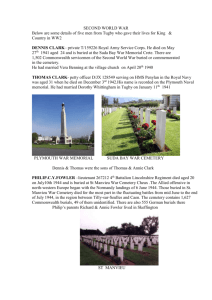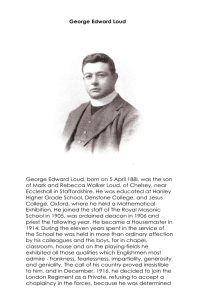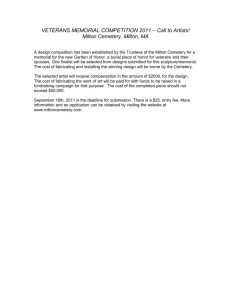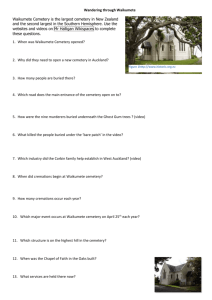Shevington War Memorial
advertisement
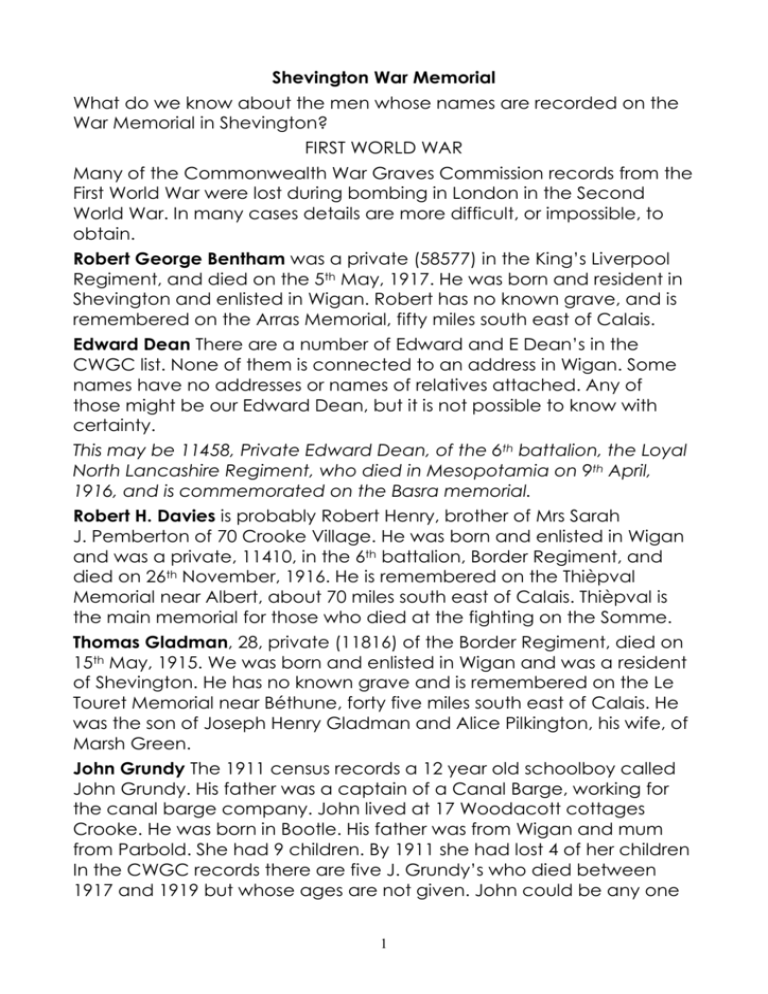
Shevington War Memorial What do we know about the men whose names are recorded on the War Memorial in Shevington? FIRST WORLD WAR Many of the Commonwealth War Graves Commission records from the First World War were lost during bombing in London in the Second World War. In many cases details are more difficult, or impossible, to obtain. Robert George Bentham was a private (58577) in the King’s Liverpool Regiment, and died on the 5th May, 1917. He was born and resident in Shevington and enlisted in Wigan. Robert has no known grave, and is remembered on the Arras Memorial, fifty miles south east of Calais. Edward Dean There are a number of Edward and E Dean’s in the CWGC list. None of them is connected to an address in Wigan. Some names have no addresses or names of relatives attached. Any of those might be our Edward Dean, but it is not possible to know with certainty. This may be 11458, Private Edward Dean, of the 6th battalion, the Loyal North Lancashire Regiment, who died in Mesopotamia on 9th April, 1916, and is commemorated on the Basra memorial. Robert H. Davies is probably Robert Henry, brother of Mrs Sarah J. Pemberton of 70 Crooke Village. He was born and enlisted in Wigan and was a private, 11410, in the 6th battalion, Border Regiment, and died on 26th November, 1916. He is remembered on the Thièpval Memorial near Albert, about 70 miles south east of Calais. Thièpval is the main memorial for those who died at the fighting on the Somme. Thomas Gladman, 28, private (11816) of the Border Regiment, died on 15th May, 1915. We was born and enlisted in Wigan and was a resident of Shevington. He has no known grave and is remembered on the Le Touret Memorial near Béthune, forty five miles south east of Calais. He was the son of Joseph Henry Gladman and Alice Pilkington, his wife, of Marsh Green. John Grundy The 1911 census records a 12 year old schoolboy called John Grundy. His father was a captain of a Canal Barge, working for the canal barge company. John lived at 17 Woodacott cottages Crooke. He was born in Bootle. His father was from Wigan and mum from Parbold. She had 9 children. By 1911 she had lost 4 of her children In the CWGC records there are five J. Grundy’s who died between 1917 and 1919 but whose ages are not given. John could be any one 1 of these, and he would have been the fifth child of the family to die young. Further information from Bernadette Green: John Grundy, private, 28327, 4th battalion, Grenadier Guards, was born in Crooke in 1898 to James and Sarah Grundy who were boat people and lived in Woodcock Row for a number of years. John was unmarried and joined the Grenadier Guards. He lost his life on 15th December 1917 at the battle of Cambrai - he was 19 years old. He was the great uncle of Bernadette Green who supplied this information. The Commonwealth War Graves Commission does not know his age. John is buried at the Le Cateau Military cemetery, approximately 27 kilometres east-south-east of Cambrai. William Halton is probably the soldier of that name buried at the Sandpits British Cemetery, Fouquereuil, near Béthune. He was a Lance Corporal (42978) in the King’s Liverpool Regiment, and died on 1st June, 1918. He was son of Thomas and Hilda Halton, of Shevington Vale. William was born in Dalton-Lees, resided in Appley Bridge and enlisted in Shevington. John James Hill, 20, was a stoker, 1st class, aboard HMS Hampshire, who died on 5th June 1916. The ship was carrying Lord Kitchener who was going to Russia to seek help for the war effort. The ship was sunk by a torpedo or a mine, and only 12 men survived. John was the son of Richard and Mary Ellen Hill, of 31, Moorfield Houses, Crooke, and is remembered on the Portsmouth Naval Memorial. Frederick Hodge (Hodges ?) may have been Private Frederick, 37530, 1st battalion King’s (Liverpool) Regiment, listed as Hodges on the Appley Bridge War memorial. He was killed in action on 3rd May 1917 aged 26, and has no known grave. He was born in the Dalton/Parbold area, and lived in Wigan. The 1911 census gives his occupation as labourer at the North West Lancs Floorcloth Company Ltd. He was the husband of Catherine Hodges of Hunter’s Hill, Wrightington, and stepson of John Atherton and Mary Hodges of Shevington Vale. Frederick is commemorated on the Arras Memorial in Pas de Calais. William Holland. There is a large number of William and W. Hollands. A possible identification could be Private William of the Lancashire Fusiliers, who died, aged 27, on 13th September, 1914. He was son of George and Esther Holland, of The Prince Albert Inn, Goose Green, Wigan, and husband of Mary Holland, of 33, Gathurst Lane, Shevington. He has no known grave but is remembered on the memorial at La Ferte-Sous-Jouarre, which was erected for the men of the British Expeditionary Force which went to France at the outbreak of 2 the First World War. La Ferte-Sous-Jouarre is a small town on the N3, forty miles east of Paris. It would appear, from what was written on a cross of remembrance left at the War Memorial and dedicated to William Holland, that my identification of him was wrong. This William Holland died in 1916 at the age of 18, but the CWGC commission does not have a record which fits those facts. This may be G/5874, Private William Holland, age unknown, of the 2nd battalion, Royal Sussex Regiment, born in Standish, and died 17th August, 1916. He is commemorated on the Thièpval, and presumably has no known grave. Richard Hooton. One Richard and two R. Hootons are listed but there is no family information. If this is Richard, the 38-year-old lance corporal, 12902, of the 9th battalion, York and Lancaster Regiment, who died on the 23rd September, 1917, he was son of Mary Hooton and “the late” William Hooton. He is remembered at the Tyne Cot Memorial at Ypres, 30 miles south east of Dunkerque in Belgium, which commemorates the battles around Ypres and Passchendaele. “Tyne Cot” is believed to have received its name from Northumberland Fusiliers who thought that German pillboxes looked liked Tyne (= Northumberland) cottages. Harry Kitchen. There are four Harry Kitchens in the CWGC records. Three come from other parts of the country. The fourth mentions Harry, a private in the Lancashire Fusiliers, who was killed on the first day of the battle of the Somme. He is remembered at Thièpval. Harry’s sisterin-law lived in the village until she died in 2010. She called her son Harry in memory of his uncle Harry Kitchen, who went “over the top” on July 1st July, 1916, and never came back. John Marshall. There is a very large number of John and J. Marshalls. However, this could well be Private John, of the King’s Liverpool Regiment, born in Skipton, Yorkshire, who died, aged 33, on 20th September, 1917. He also is remembered at Tyne Cot, and he probably died during the Battle of Passchendaele. John is recorded as the son of James and Jane Marshall, of 47, Crooke, Wigan, and husband of Elizabeth Ann Marshall, of 55, Crooke. Edward Stopforth, 26, private in the Loyal North Lancashire Regiment, died on 22nd November, 1916. He was the son of Edward and Nancy Stopforth, of 79, Gathurst Lane, Shevington, and, having no known grave, is remembered at Thièpval. Harry Randolph Taylor, 27, a rifleman (473947) of the 12th battalion London Regiment, (the Rangers), died on 27th November, 1917. He was born in Wigan but lived and enlisted in Bristol. He is remembered at the 3 Cambrai Memorial at Louveral, about 60 miles south east of Calais as his body was never recovered. Harry was the son of Matthew Butterworth Taylor and Hannah Taylor, of “Wellsdale”, Gathurst Lane, Shevington. The house is still to be seen. Matthew Butterworth Taylor was one of the original trustees of the Shevington Recreation Ground. Perhaps he became involved because of the death of his son. Oswald Wilson, 20, a private in the 4th battalion, King’s Liverpool Regiment, died on 29th November, 1918, of wounds received on 5th November, as his battalion was crossing the Sambre canal on the edge of the Forest or Mormal. He was son of Christopher and Teresa Wilson, of Brook Side, Shevington Moor. He is buried at the St Sever Cemetery at Rouen. There was an interesting article on The Reporter of 29th November, 2007. Oswald Wilson’s wooden battlefield cross was found in a shop in Todmorden, Lancashire, as a result of a house clearance. This grave marker would have been on Oswald’s grave before it was replaced a few years later with the normal headstone. Thomas Jackson must be 49066, Serjeant T. Jackson, of the 2nd Battalion, the Northumberland Fusiliers, who died on at the age of 28 on 23rd October, 1918. He was born in Wigan but enlisted in Dinnington, Northumberland. He was the son of William and Mary Ellen Jackson, of 10, Shevington Lane, Shevington, and is buried in the Basra War Cemetery. Then, as now, oil was the issue. Allied operations in Mesopotamia (largely present-day Iraq) were against the Turks, staunch fighters and allies of the Germans. British troops invaded Mesopotamia and captured Basra in 1914 and for the rest of the war fought their way northwards. Thomas Jackson was unlucky to die such a short time before the armistice. SECOND WORLD WAR Colin Fazackerley Coppock lived at 137 Shevington Lane, and was married to Edna. They were both musical, and Edna played the organ and trained the choir at Almond Brook Methodist Church, which is now a private house. They had one son, Alan. Colin volunteered for the marines when war broke out, and was trained, like so many before and since, in Plymouth. In 1941 he was on board HMS Neptune which, as part of Force K, was sent to attack German and Italian convoys supplying German troops in North Africa. 4 On December 20th, 1941, twenty miles off the African coast, at one o’clock in the morning, HMS Neptune hit a mine which damaged her bow. She backed into another mine which blew off the propeller. At 4.00am, the ship hit a third mine and sank within five minutes. Since a storm was blowing, there was no possibility of rescue from the other ships, and there was only one survivor. Colin and 763 others were listed as MPK (missing presumed killed). He is remembered on our war memorial and at Plymouth. Some years later, Mrs Coppock remarried. Alan was five when his father died, and he has memories of Colin coming home on leave and giving him chocolate bars. Alan, like both his parents, is an organist and for some years he has been the organist at a church in the Lake District. Now he lives in Southport, and this makes it possible for him to come to the Remembrance Day service in Shevington each year and leave a beautiful wreath. Alan also joined the navy, and once, when his ship was in the Mediterranean, they passed over the spot where the Neptune went down. It was, as you can imagine, a poignant moment. His devotion to Wigan seems to have begun early. He recalls that, when he was born in Barnet in North London where the family was living at the time, his parents bundled him into a car and drove through the night to bring him to Wigan to be registered! Private Joseph Fitzpatrick, 24, of the King’s Liverpool Regiment, was killed on 21st October, 1944 while operating behind enemy lines with Orde Wingate’s Chindits. He was the son of Stephen and Alice, of Appley Bridge. He is buried in Rangoon. Cyril Haig, 26, whose name is given as Hague by the CWGC, was a gunner in the Leicester Yeomanry. He died on 1st January, 1946, as a member of the occupation forces. He is buried in Cologne. He was son of William Birchall Hague and Jane Hague and husband of Alice Hague, of Crooke. Alan Paul Telford Henry was a sergeant, wireless operator and rear gunner, in the Royal Air Force Volunteer Reserve. He died at the age of 19 on 11th December, 1944, presumably in this country, and is buried in St Anne’s churchyard. He was the son of Stephen and Hannah Henry, of Shevington. Frank Walker Highton, 26, was an engine room artificer based at H.M.S.Sultan which was the main naval land base in Singapore. He died on 16th February, 1942, one day after the surrender of Singapore, probably during the destruction of the base. He has no known grave 5 and is remembered at the Chatham Naval Memorial. He was son of James and Annie Highton, of Shevington. John Henry Holcroft, 25, was a sergeant in the Royal Army Service Corps. He died on 31st December, 1943, as prisoner of the Japanese and is buried in the Kanchanaburi Cemetery. This cemetery is 70 miles from Bangkok, Thailand, and John probably died when working on the Burma Railway. He was son of Robert Henry and Elizabeth Holcroft, of Appley Bridge. James Lamb, 29, was a sapper in the Royal Engineers. He died in Italy on 1st November, 1944 and is buried at the Coriano Ridge Cemetery, on the Adriatic coast east of Florence. The Italians had surrendered in 1943, but the Germans had not, and fighting continued in the north until 1945. James was son of Henry and Mary Lamb and husband of Louisa Lamb, of Crooke. Eric Lyon, 25, flying officer with the R.A.F. Volunteer Reserve, was killed on 4th October 1942 while flight testing a Beaufighter in Scotland. He was son of James and Annie Lyon, of Shevington, and husband of Margaret Lilian Lyon, of Gathurst, and is buried in St Anne’s churchyard. Harry Mayers, 29, was a private in the Manchester Regiment. He was killed in a road accident in Northumberland on 28th October, 1939. He may have been the pianist at the Plough and Harrow. He was son of Thomas and Annie Mayers, and husband of Emily Mayers, of Whelley, and is buried in St Anne’s. In 1996, Emily was buried with him, fifty seven years later. John Victor Randall, family and age unknown to the CWGC, but apparently one of the five sons of (Jack?) Randall of Randall’s Corner, was a sergeant in the R.A.F. He was killed when his Manchester bomber from Woolfax Lodge in Lincolnshire exploded and crashed into the sea off Boulogne. Remembered on the R.A.F. Runnymede Memorial, on the Thames near Windsor. John Edward Rigby, 21, a flying officer in the R.A.F. Volunteer Reserve, was killed on the 24th May, 1943. He was pilot of a Lancaster bomber which took off from Snaith to bomb Dortmund but was shot down over the Leiden area of Holland during the return. He was son of William Albert and Ethel Rigby, of Appley Bridge, and is buried in Oegstgeest Protestant Cemetery, ten miles North West of The Hague. Ernest Lawrence Snape, 27, a guardsman in the Grenadier Guards, died on 5th December, 1943 in Italy. He was part of the force which invaded Italy on 3rd September, 1943 and fought its way northwards. 6 He is buried at Minturno, 45 miles north of Naples, and was son of William Lawrence Snape and Sarah Ellen Snape, and husband of Elizabeth Snape, of Shevington Moor. John McNamara Sergeant John Robert McNamara (spelled MacNamara in the CWGC website), 1675090, was an air gunner with 150 Squadron Royal Air Force Volunteer Reserve. His Lancaster was shot down on 12th December, 1944 on a raid to Essen. John is buried in the Reichswald Forest War Cemetery. He was married to Veronica (nee Burns) and they had one son, Tony (Robert Anthony). They did live on Broadriding Road and, possibly, at some point in Crooke Village. This information was supplied by his daughter-in-law, Lynn MacNamara. Information for this article has come mostly from the Commonwealth War Graves Commission website. Several interesting details about men in the Second World War are taken from “Roll of Honour” a list of the names on the war memorials in and around Wigan, researched and compiled by Eric McPherson, Anzio Publishing, ISBN 0-9540325-0-0. Ella Atherton has supplied some details: The memorial stone was a gift from Frank Finch who owned Central Quarries (sometimes call Platt and Co.) in Appley Bridge. It was cut by Ella’s husband, Jack, from a larger piece, and Jack shaped the stone. Halliwells who were farmers delivered the stone to the Memorial Park probably in 1947, but the names were not attached until later. The stone was dedicated by the curate, Geoffrey Stevens, in 1954. In addition several small crosses have been left at the War Memorial in recent years. One was dedicated to “Richard Johnson, died 1918”. Richard is not on our War Memorial. Who was he? Another mentioned “Joseph Holland, my dad, RAF” and “Jimmy Gregory, my brother, Royal Artillery”. Another was dedicated to Jo Fitzpatrick, the Chindit, who is buried in Rangoon. Other crosses mentioned “Bill Robinson and friends”, “John Fisher, and William Lyon SNR”. There was a cross to the Land Army Girls, “no longer with us”. Readers may be aware that one Land Army girl who died only recently was Joyce Miles of Old Lane. The most interesting name on the little crosses was “Harold Green, Korea”. 22530290 Private H. Green, of the Gloucester Regiment, born 18th July, 1926, was killed on 26th April 1951 at the age of 24 at the battle of the Imjin River, and is buried in the United Nations Memorial Cemetery, Pusan, Korea. 1,078 British soldiers were killed in Korea. If Private Green had a connection with Shevington, perhaps his name should be on our memorial. 7 If you can add to the stories of any of these men, please get in touch – 01257 423342. 8
